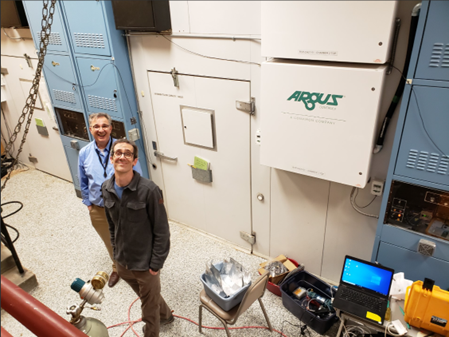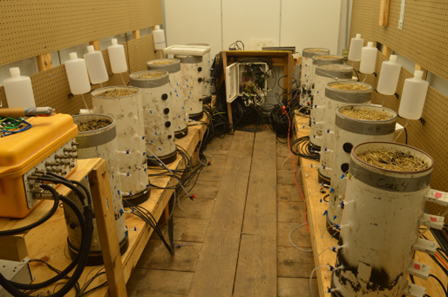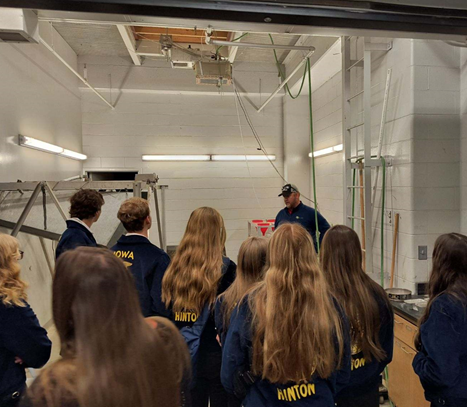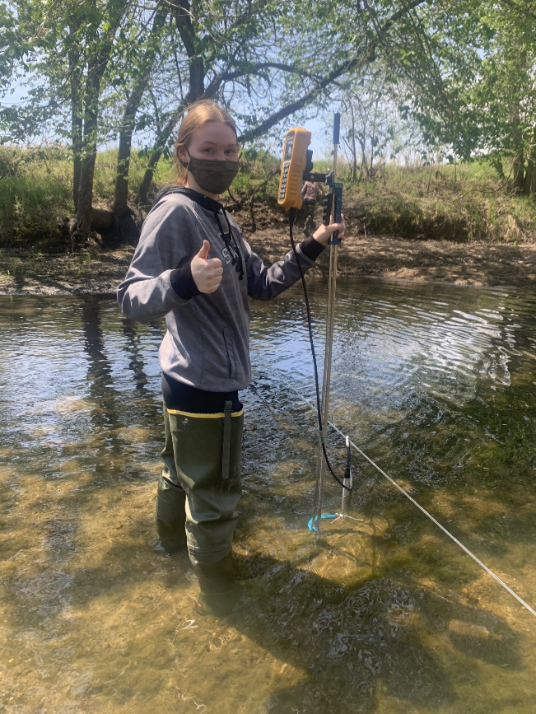| Hello Stakeholders - Spring 2023 Update! |

|
Hello Stakeholders,
Research in the lab is going strong, and this week, we had two groups of FFA students into the lab to learn about our resources and the equipment we use. We took a few pictures and thought you might enjoy seeing how agriculture can still light a flame of enthusiasm in people who are considering agricultural career paths.
Kevin Cole, Physical Scientist, (below, right of monitor) presented how NLAE uses small Unmanned Aircraft Vehicles for research. UAV based multi-spectral, LiDAR and thermal sensors were demonstrated. The application of these tools to agricultural issues such as mapping, crop stress, soil moisture, and soil erosion indicators was presented. Future Farmers of America students interacted with the UAVs and discussed how this technology is used in agriculture today and its future potential. Pictured is Kevin Cole next to real-time thermal images of the FFA students. Two of our drones are also pictured.


Dr. Bryan Emmett, Research Microbiologist, (below, right) in collaboration with Iowa State University PhD Candidate and graduate student Yunjiao Zhu, presented a controlled environmental drainage experiment testing how tile drainage infrastructure impacts soil greenhouse gas emissions and nitrogen loss. Intact soil cores, and the setup for automated greenhouse gas sampling, subsoil gas measurements, and subsoil pore water measures will be discussed along with their relation to the experimental objectives. Students watched from the upper level as Dr. Emmett (pictured here with NLAE Director Dr. Thanos Papanicolaou below, left), demonstrated the technology in our large rhizotron room where the soil cores are connected to a wide variety of sensors and data collectors.


David DenHaan, Physical Science Tech., (below, left) introduces the work of the Analytical Lab at NLAE. He described some of the instrumentation in the lab including carbon nitrogen combustion analysis, stable isotope ratio mass spectroscopy, and inductively coupled plasma (ICP). David demonstrated emission spectroscopy, used in ICP, by introducing various chemicals to a torch flame showing how different colors are produced that are unique to the elements present.

Dr. Kenneth Wacha, Hydrologist, (below) gave a presentation to the FFA students about erosion. Rainfall simulators are a valuable research tool that allows us to create controlled rainfall events of varying intensities and observe their direct impact on runoff, sediment, and nutrient transport. We have found that as rainfall intensity increases, so does the runoff, which can lead to more soil and nutrient loss from the fields. This runoff carries not only excess water but also sediments and nutrients, potentially causing erosion and depleting the soil of its fertility. Moreover, the transport of nutrients like nitrogen and phosphorus can negatively impact water quality. Information from our rainfall simulation experiments is being used to develop sustainable farming practices that can reduce environmental degradation and promote efficient water use for crop growth.

Patrick Quance, (below, left) Facilities Operations Specialist, discusses the history and capabilities of the "experimental environmental chambers/rhizotrons" the location has. The rhizotrons allow researchers to perform year round research on crop and soil conditions in a controlled environment. The rhizotrons are able to replicate temperature ranges from 42- 120 degrees with a variety of lighting conditions. The lighting is able to replicate a dawn to dusk environment. Future upgrades will enable a hard frost environment to be simulated to study the effects of frost on plant growth in varying stages of development.

Bert Swalla, Physical Science Tech., (above, right), pictured here with Patrick Quance (above, left), arranged this week's FFA student tours. Bert, Patrick, and Katie Hanenburg, Hydrology tech., (pictured below in the river) actively engage in outreach to students and the community for NLAE. Bert's charismatic presentations of worm composting with red wrigglers have resulted in the students calling him "The Worminator." Bert, Patrick, and Katie's next student outreach will be at the USDA National Animal Disease Center on Dayton Ave in Ames during the second week in May.

Thank you everybody! The FFA high schoolers were visibly energized by the presentations.
NLAE has now a new Dry Fertilizer Applicator for Research just in Time!
A new Dry Fertilizer plot Applicator has been recently built in the NLAE shop under the guidance of NLAE farm Manager Ben Knutson to enable application of all types of dry fertilizer or other soil amendments to research plots at the right place, right rate, right timing, and with the right source (the 4Rs for nutrient stewardship). Three First Products fertilizer application boxes were installed on a tractor mounted 3-point bar. Each application box has 4 metered outlets with positive displacement augers to provide amounts of the applied dry fertilizer. Diffusers were added and placed 15” apart to spread the fertilizer evenly across the plot area. An Ag Leader InCommand 1200 is used to control the application rate. A sub-inch GPS system is used to ensure accurate plot/field position and application rate. Rates can be changed automatically for each plot, soil type, or by prescription map. An as-applied application map is recorded for post processing. Calibration is done in a 3-step process for each product to ensure the correct application rate and can be saved for future reference if needed. The First Products application boxes and metering system are easier to clean than most dry fertilizer applicators and made of stainless steel to resist the corrosive nature of fertilizer.

We hope you also see yourselves participating in some of the research happening at NLAE. Your support and interactions are instrumental to increasing the impact of our work. We very much look forward to seeing you soon and working together. Please visit our web site for the latest news and updates National Laboratory for Agriculture and The Environment : USDA ARS
